Highlight
– Vitamin D deficiency is highly prevalent among women with PCOS and is implicated in endocrine and metabolic dysregulations.
– Weekly high-dose vitamin D3 supplementation (30,000 IU) over 24 weeks improved ovarian morphology and menstrual cycle regularity.
– Increased ovulation rates and reduced androgen (testosterone) levels were observed, particularly in patients with elevated LH/FSH ratios.
– Vitamin D3 could serve as a standalone or adjunctive treatment option to improve reproductive outcomes in PCOS.
Study Background and Disease Burden
Polycystic ovary syndrome (PCOS) is a common endocrine disorder affecting approximately 6–15% of women of reproductive age worldwide. It is characterized by hyperandrogenism, oligo/anovulation, and polycystic ovarian morphology. Women with PCOS often endure menstrual irregularities and infertility, alongside associated metabolic disturbances such as insulin resistance and obesity. Vitamin D deficiency is frequently reported in this population and is hypothesized to exacerbate both endocrine and metabolic dysfunctions. Vitamin D receptors and metabolizing enzymes are expressed in ovarian tissue, suggesting that vitamin D may influence follicular development and steroidogenesis via modulation of gene expression. These mechanistic insights have motivated investigations into vitamin D’s therapeutic potential in ameliorating PCOS symptoms.
Study Design
The referenced study by Tóth et al. employed a prospective, double-blind, two-phase, parallel-group, placebo-controlled randomized clinical trial enrolling women with PCOS. Exclusion of concurrent metformin use isolates the effects of vitamin D3 supplementation on ovarian function. Participants received 30,000 IU/week of vitamin D3 combined with calcium supplementation for the first 12 weeks, followed by another 12 weeks of vitamin D3 treatment without placebo crossover. Control participants received placebo with calcium for 12 weeks. Key endpoints included changes in ovarian morphology assessed by transvaginal ultrasonography (TVUS), menstrual cycle regularity, ovulation rates, and serum hormonal profiles including testosterone and LH/FSH ratio. Assessments were completed at baseline, 12 weeks, and 24 weeks.
Key Findings
More than half of the patients receiving vitamin D3 demonstrated significant improvements in multiple clinical outcomes over 24 weeks. Specifically:
- Ovarian Morphology: TVUS revealed a reduction in the typical polycystic ovarian appearance, including decreased ovarian volume and follicle count, indicative of improved follicular development.
- Menstrual Regularity: A marked improvement in menstrual cycle length and frequency was observed, with more women experiencing regular ovulatory cycles compared to placebo.
- Ovulation Rate: Vitamin D3 treatment yielded a significantly increased ovulation rate, a critical factor for fertility restoration in PCOS.
- Hormonal Changes: Notably, in patients presenting an LH/FSH ratio greater than 2, a subgroup characteristic of more pronounced endocrine disruption, mean serum testosterone levels were significantly reduced post-treatment, suggesting mitigation of hyperandrogenism.
The study reported that vitamin D3 supplementation was well tolerated, with no significant adverse safety signals. Improvements observed were beyond spontaneous remission or placebo effects due to the controlled design.
Expert Commentary
The trial rigorously addresses a noteworthy clinical gap by focusing on vitamin D3 effects independent of insulin-sensitizing agents such as metformin. By targeting gene expression pathways influencing folliculogenesis and steroid hormone synthesis, vitamin D3 offers a plausible mechanistic basis for observed improvements. However, the study’s limitations include a relatively small sample size and short follow-up duration, which may impact generalizability and long-term outcome assessment. Further trials with larger cohorts and inclusion of metabolic endpoints could enrich understanding. Current clinical guidelines vary regarding routine vitamin D supplementation in PCOS, but this work supports incorporation of vitamin D status assessment and correction as part of comprehensive management strategies.
Conclusion
This prospective, double-blind randomized controlled trial substantiates that weekly vitamin D3 supplementation at 30,000 IU significantly improves ovarian morphology, menstrual regularity, and ovulation in women with PCOS. Reductions in hyperandrogenism, particularly among patients with elevated LH/FSH ratios, were also demonstrated. These findings advocate for vitamin D3 as either a standalone or adjunctive therapeutic modality in the management of PCOS, addressing both reproductive and endocrine disturbances. Integration of vitamin D screening and tailored supplementation should be considered in clinical practice pending further confirmatory research.
References
1. Tóth BE, Takács I, Valkusz Z, Jakab A, Fülöp Z, Kádár K, Putz Z, Kósa JP, Lakatos P. Effects of Vitamin D3 Treatment on Polycystic Ovary Symptoms: A Prospective Double-Blind Two-Phase Randomized Controlled Clinical Trial. Nutrients. 2025 Apr 2;17(7):1246. doi: 10.3390/nu17071246. PMID: 40219003; PMCID: PMC11990587.
2. Rotterdam ESHRE/ASRM-Sponsored PCOS Consensus Workshop Group. Revised 2003 consensus on diagnostic criteria and long-term health risks related to polycystic ovary syndrome. Fertil Steril. 2004;81(1):19–25.
3. Pal L, Donahue L, Legro RS. Role of vitamin D in polycystic ovary syndrome and metabolism. Endocrinol Metab Clin North Am. 2015;44(1):145-56.


